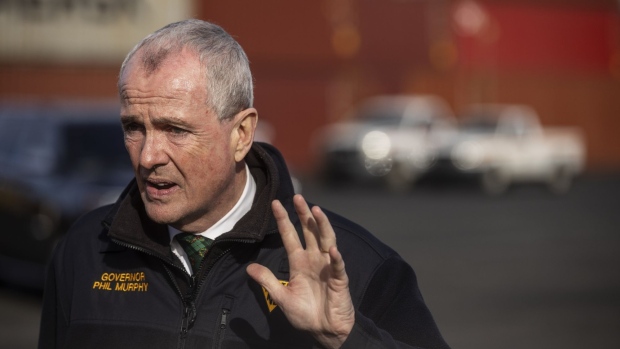Mar 30, 2022
NJ Transit Riders Spared Fare Increases at Expense of Major Improvement Projects
, Bloomberg News

(Bloomberg) -- Four years after Governor Phil Murphy vowed to stop a budgeting practice that starves New Jersey Transit of long-term bus and rail improvements, documents show the agency counting on the practice throughout his two terms.
From fiscal 2023-2026, the largest U.S. statewide transportation provider is projecting a shift of $1.5 billion from its capital budget to pay for day-to-day needs, agency records show. That’s atop the $1.7 billion that Murphy moved in his first four years.
For the governor, a 64-year-old Democrat and a retired Goldman Sachs Group Inc. senior director, juggling funds has a reward: Boosting the operating budget with annual cash transfers, he’s promised no fare increases for five straight years.
That’s a politically savvy move. But transportation advocates say it has a serious downside for an agency trying to overcome years of financial neglect.
“You’re tying up the agency’s ability to carry out its capital program,” said Janna Chernetz, New Jersey policy director for the Tri-State Transportation Campaign, a non-profit policy group. “You’re borrowing from your future.”
Plugging Holes
Since 1990, New Jersey governors have filled holes in the bus and train provider’s operating budget with more than $9 billion in capital cash. Murphy came to office in 2018 with a promise to turn around NJ Transit, key to New York City jobs, after budget cuts by his predecessor, Chris Christie, led to record rail breakdowns and safety lapses.
“Governor Murphy has pursued an aggressive capital improvement program for NJ Transit, including overhauls of key transit hubs such as Newark Penn Station,” said Murphy spokesman Michael Zhadanovsky.
A study commissioned by Murphy in his first year called NJ Transit’s overall budgeting “inadequate, uncertain and unsustainable.” Draining money earmarked for big projects, it said, led to “unintended long-term consequences” of deteriorating assets and unhappy riders.
The governor has said it’s a poor practice and must stop, even if it’s allowed under federal rules. Still, at the end of his two terms he will have shifted more than $3 billion intended for major projects. At the same time, no funding is in place for a $411 million high-speed commuter-ferry service and $340 million in train platform and other safety fixes at New York’s Penn Station.
In Murphy’s first term, he shifted about $1.7 billion, or $200 million more than Christie did in the same period of his governance. Over the next four years, Murphy will have pushed the overall capital-to-operating transfer to over $10 billion since 1990. Murphy’s share at the end of two terms would be about 30% of the total by all New Jersey governors, behind Christie’s 34%.
Nancy Snyder, an NJ Transit spokeswoman, said federal and state rules allow the transfers for maintenance needs, such as engine overhauls and new tires, on trains, buses and other equipment.
“These non-routine projects not only extend the useful life of the asset being repaired but also help keep it in a state of good repair,” Snyder said in a statement.
In an interview this month, Murphy said his administration was tackling “decades of bad practices” at NJ Transit.
Murphy has boosted the ranks of train engineers to full staffing, finished a federally mandated emergency braking project that had stalled for years and committed NJ Transit to a bridge replacement project with the biggest contract in its history. The state has also pledged to fund a portion of the $12.3 billion rehabilitation and construction of Hudson River rail tunnels.
“We want to make the NJ Transit experience so compelling that you say to yourself: It’s not worth driving a car,” Murphy said.
Budget Shortfalls
NJ Transit outlined a five-year capital plan of $15.1 billion in 2020. The transfer of funds from the capital to operating budgets, though, has contributed to a $4.8 billion funding gap on that long-term list.
One plan that awaits funding would purchase 12 high-speed ferry vessels, each with room for 350 passengers. The fleet “would improve trans-Hudson capacity, improve customer comfort and help mitigate future growth strains on the transit systems linking New Jersey residents to New York City,” according to its project sheet.
Other needs include $340 million for improvements at New York’s Penn Station to relieve platform congestion, a chief safety complaint from riders. Hundreds of millions of dollars more would modernize 16 bus maintenance garages and pay for station, track, rail yard, signal, bridge and technology upgrades.
Murphy has directed almost $4 billion in New Jersey Turnpike Authority tolls to NJ Transit budget needs through fiscal 2028. The arrangement after that is uncertain, as Murphy is limited to two terms and leaves office in four years.
For fiscal 2026, NJ Transit is projecting a $550 million shortfall in its $3 billion budget. That’s despite all the funding sources in use now, including a state subsidy, the turnpike tolls, a clean-energy fund contribution, the capital-to-operating shift and federal pandemic relief.
Ridership in 2025 is expected to be 10% short of pre-Covid levels, according to NJ Transit planning documents. The agency expects as much as 15% of passengers won’t board five days a week because of the flexible work arrangements that became commonplace during the pandemic.
Still, NJ Transit is projecting no fare increases.
“I don’t want to take anything from holding fares stable, but it comes at a cost: risking fare hikes down the road,” said Chernetz, the mass-transit advocate. “The success you have is temporary.”
©2022 Bloomberg L.P.


